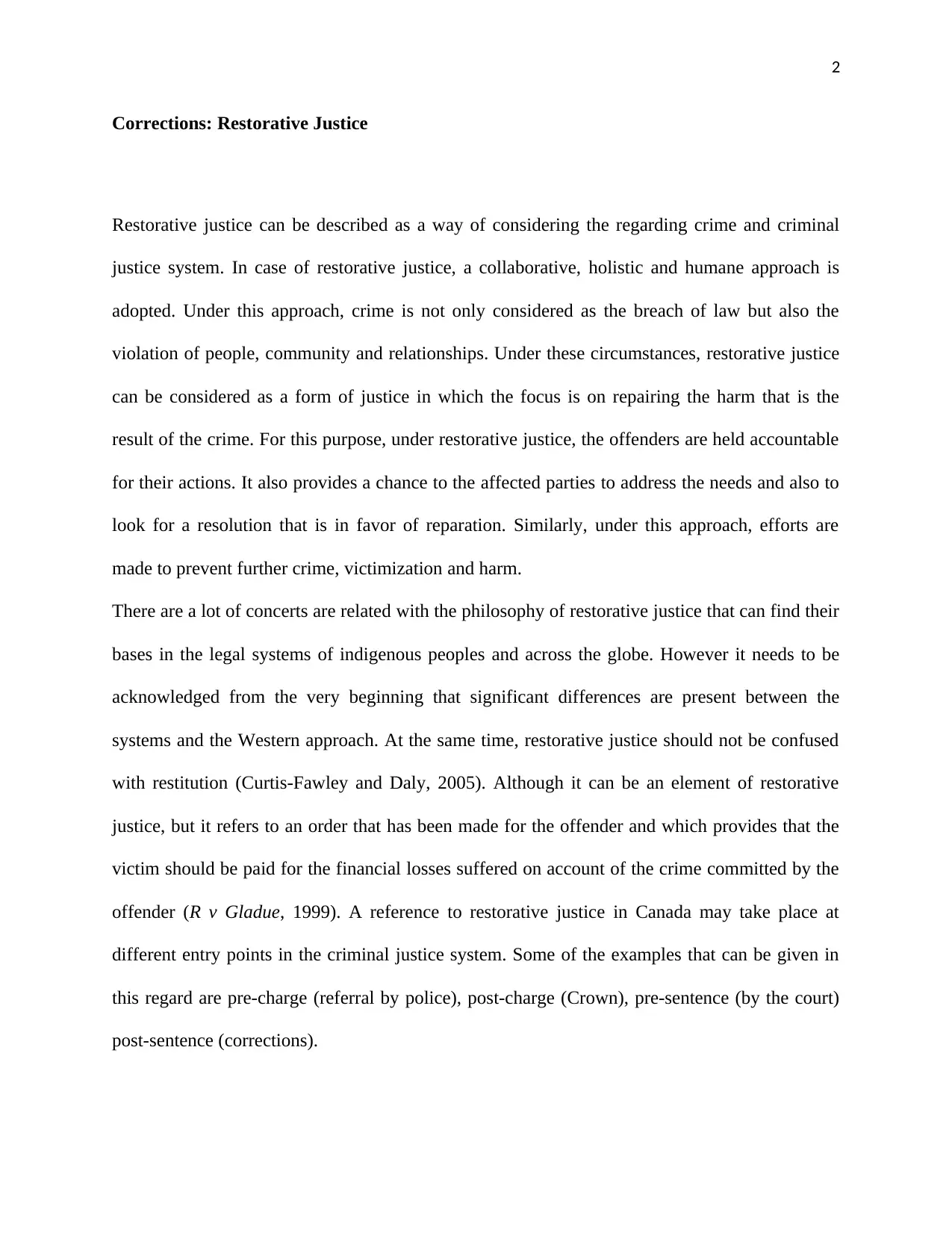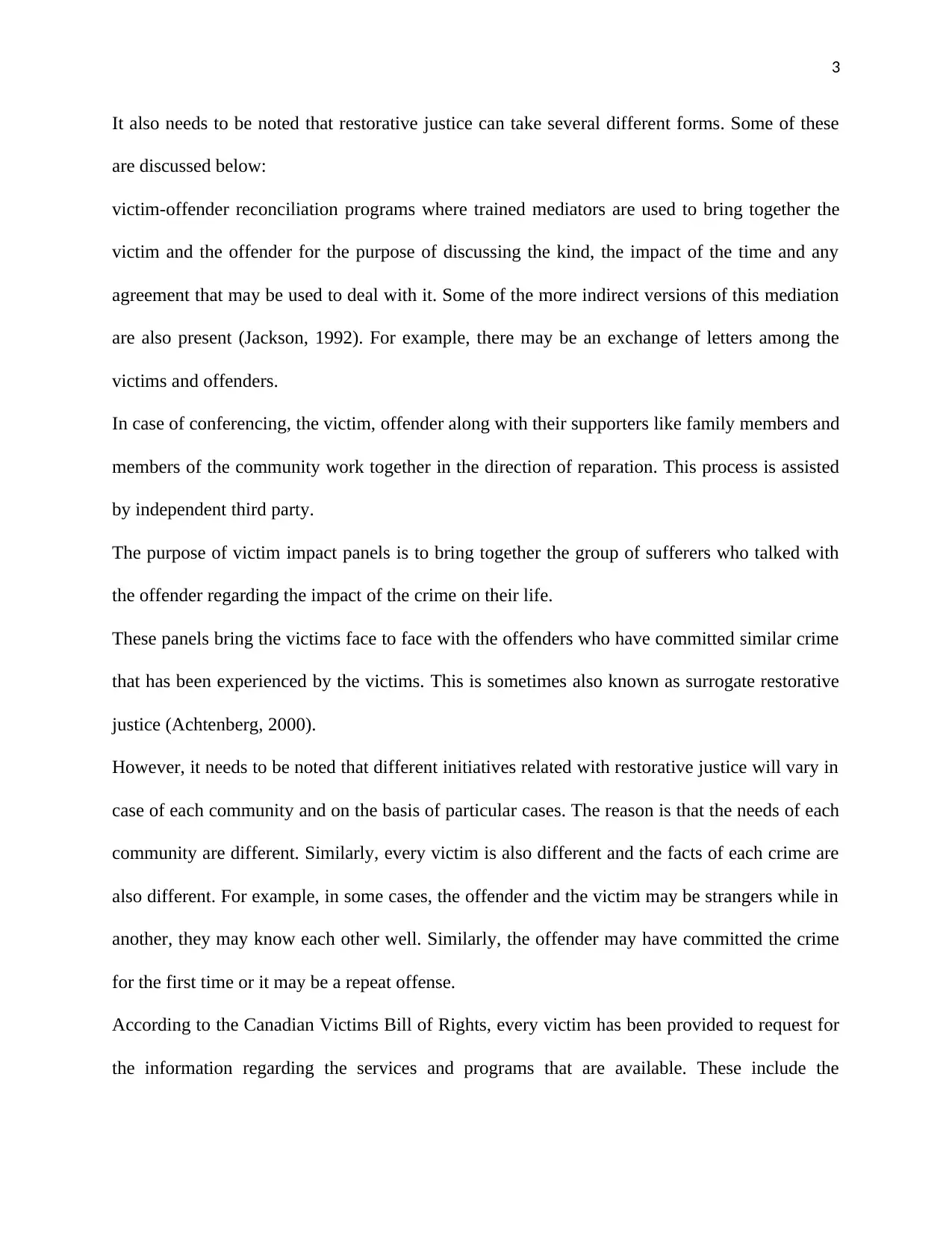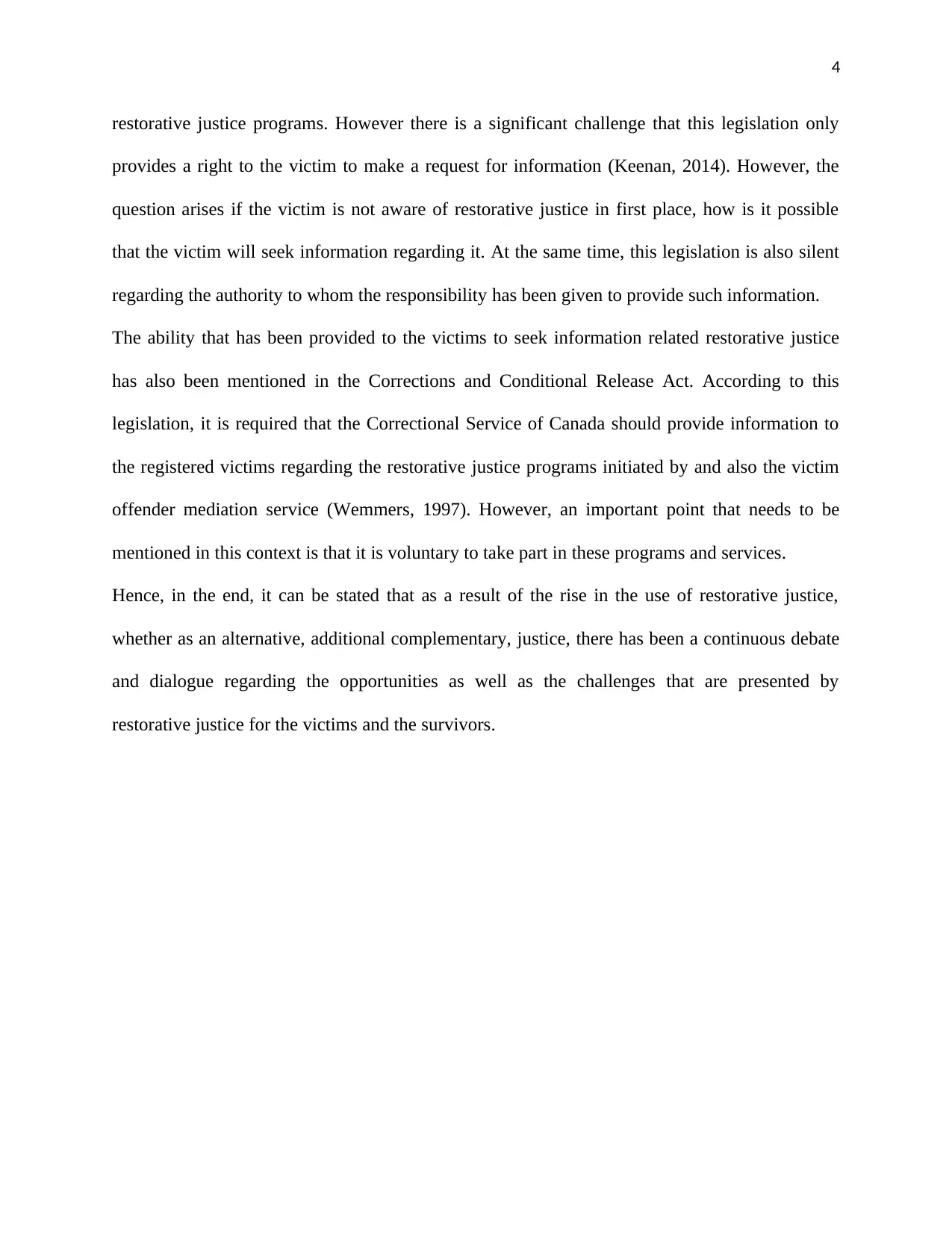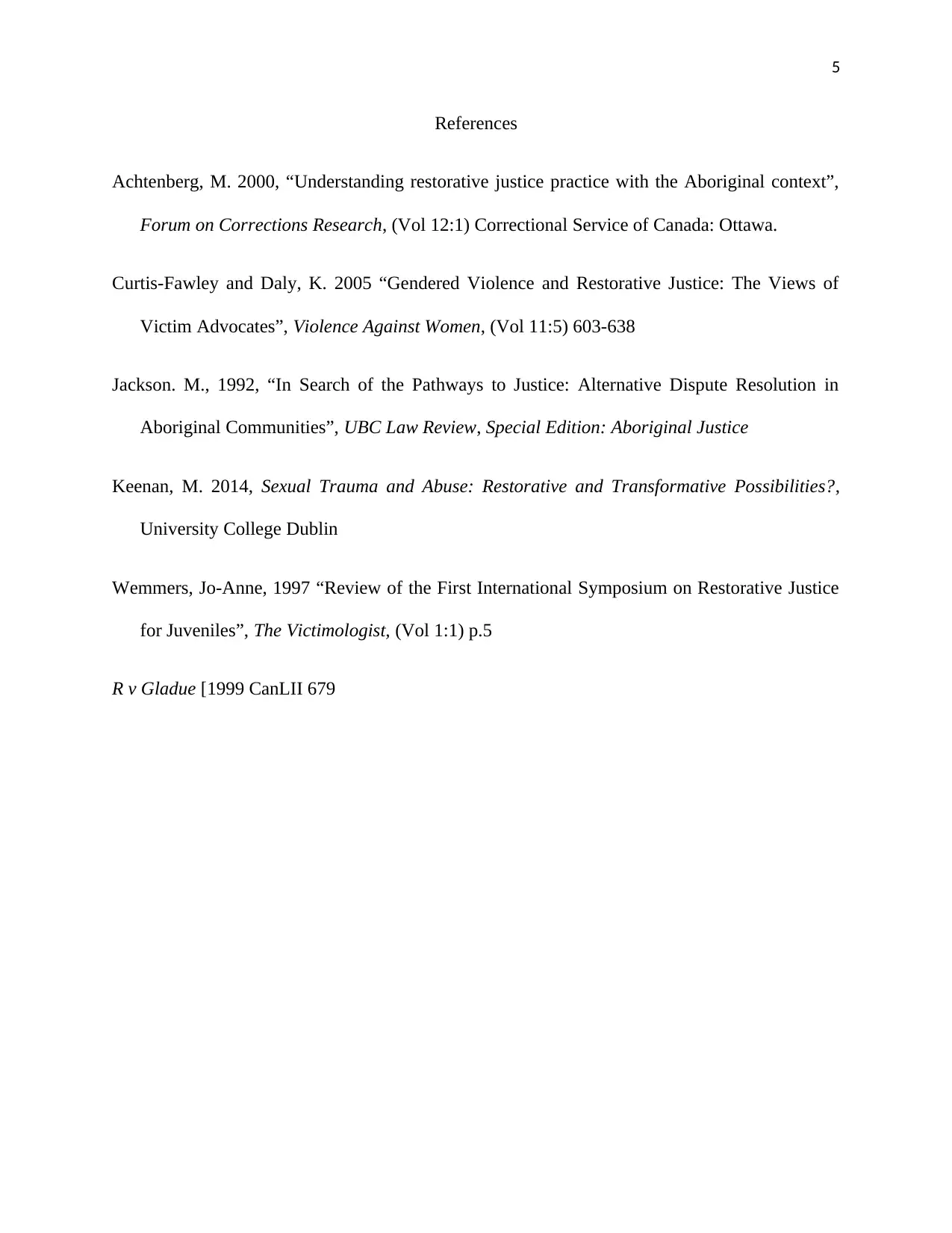Restorative Justice in Practice: Concepts, Benefits and Challenges
VerifiedAdded on 2023/06/03
|5
|1084
|295
Essay
AI Summary
This essay provides an overview of restorative justice, defining it as a collaborative and humane approach to crime that focuses on repairing harm to victims, communities, and relationships. It contrasts restorative justice with traditional punitive measures and restitution, highlighting its roots in indigenous legal systems. The essay outlines various forms of restorative justice, including victim-offender reconciliation programs, conferencing, and victim impact panels, noting their adaptability to different communities and cases. It also discusses the Canadian Victims Bill of Rights and the Corrections and Conditional Release Act, pointing out the challenges in ensuring victims are aware of and can access restorative justice programs. The essay concludes by acknowledging the ongoing debate surrounding the opportunities and challenges that restorative justice presents for victims and survivors.

1
Student Name:
Date:
Institution:
Student Name:
Date:
Institution:
Paraphrase This Document
Need a fresh take? Get an instant paraphrase of this document with our AI Paraphraser

2
Corrections: Restorative Justice
Restorative justice can be described as a way of considering the regarding crime and criminal
justice system. In case of restorative justice, a collaborative, holistic and humane approach is
adopted. Under this approach, crime is not only considered as the breach of law but also the
violation of people, community and relationships. Under these circumstances, restorative justice
can be considered as a form of justice in which the focus is on repairing the harm that is the
result of the crime. For this purpose, under restorative justice, the offenders are held accountable
for their actions. It also provides a chance to the affected parties to address the needs and also to
look for a resolution that is in favor of reparation. Similarly, under this approach, efforts are
made to prevent further crime, victimization and harm.
There are a lot of concerts are related with the philosophy of restorative justice that can find their
bases in the legal systems of indigenous peoples and across the globe. However it needs to be
acknowledged from the very beginning that significant differences are present between the
systems and the Western approach. At the same time, restorative justice should not be confused
with restitution (Curtis-Fawley and Daly, 2005). Although it can be an element of restorative
justice, but it refers to an order that has been made for the offender and which provides that the
victim should be paid for the financial losses suffered on account of the crime committed by the
offender (R v Gladue, 1999). A reference to restorative justice in Canada may take place at
different entry points in the criminal justice system. Some of the examples that can be given in
this regard are pre-charge (referral by police), post-charge (Crown), pre-sentence (by the court)
post-sentence (corrections).
Corrections: Restorative Justice
Restorative justice can be described as a way of considering the regarding crime and criminal
justice system. In case of restorative justice, a collaborative, holistic and humane approach is
adopted. Under this approach, crime is not only considered as the breach of law but also the
violation of people, community and relationships. Under these circumstances, restorative justice
can be considered as a form of justice in which the focus is on repairing the harm that is the
result of the crime. For this purpose, under restorative justice, the offenders are held accountable
for their actions. It also provides a chance to the affected parties to address the needs and also to
look for a resolution that is in favor of reparation. Similarly, under this approach, efforts are
made to prevent further crime, victimization and harm.
There are a lot of concerts are related with the philosophy of restorative justice that can find their
bases in the legal systems of indigenous peoples and across the globe. However it needs to be
acknowledged from the very beginning that significant differences are present between the
systems and the Western approach. At the same time, restorative justice should not be confused
with restitution (Curtis-Fawley and Daly, 2005). Although it can be an element of restorative
justice, but it refers to an order that has been made for the offender and which provides that the
victim should be paid for the financial losses suffered on account of the crime committed by the
offender (R v Gladue, 1999). A reference to restorative justice in Canada may take place at
different entry points in the criminal justice system. Some of the examples that can be given in
this regard are pre-charge (referral by police), post-charge (Crown), pre-sentence (by the court)
post-sentence (corrections).

3
It also needs to be noted that restorative justice can take several different forms. Some of these
are discussed below:
victim-offender reconciliation programs where trained mediators are used to bring together the
victim and the offender for the purpose of discussing the kind, the impact of the time and any
agreement that may be used to deal with it. Some of the more indirect versions of this mediation
are also present (Jackson, 1992). For example, there may be an exchange of letters among the
victims and offenders.
In case of conferencing, the victim, offender along with their supporters like family members and
members of the community work together in the direction of reparation. This process is assisted
by independent third party.
The purpose of victim impact panels is to bring together the group of sufferers who talked with
the offender regarding the impact of the crime on their life.
These panels bring the victims face to face with the offenders who have committed similar crime
that has been experienced by the victims. This is sometimes also known as surrogate restorative
justice (Achtenberg, 2000).
However, it needs to be noted that different initiatives related with restorative justice will vary in
case of each community and on the basis of particular cases. The reason is that the needs of each
community are different. Similarly, every victim is also different and the facts of each crime are
also different. For example, in some cases, the offender and the victim may be strangers while in
another, they may know each other well. Similarly, the offender may have committed the crime
for the first time or it may be a repeat offense.
According to the Canadian Victims Bill of Rights, every victim has been provided to request for
the information regarding the services and programs that are available. These include the
It also needs to be noted that restorative justice can take several different forms. Some of these
are discussed below:
victim-offender reconciliation programs where trained mediators are used to bring together the
victim and the offender for the purpose of discussing the kind, the impact of the time and any
agreement that may be used to deal with it. Some of the more indirect versions of this mediation
are also present (Jackson, 1992). For example, there may be an exchange of letters among the
victims and offenders.
In case of conferencing, the victim, offender along with their supporters like family members and
members of the community work together in the direction of reparation. This process is assisted
by independent third party.
The purpose of victim impact panels is to bring together the group of sufferers who talked with
the offender regarding the impact of the crime on their life.
These panels bring the victims face to face with the offenders who have committed similar crime
that has been experienced by the victims. This is sometimes also known as surrogate restorative
justice (Achtenberg, 2000).
However, it needs to be noted that different initiatives related with restorative justice will vary in
case of each community and on the basis of particular cases. The reason is that the needs of each
community are different. Similarly, every victim is also different and the facts of each crime are
also different. For example, in some cases, the offender and the victim may be strangers while in
another, they may know each other well. Similarly, the offender may have committed the crime
for the first time or it may be a repeat offense.
According to the Canadian Victims Bill of Rights, every victim has been provided to request for
the information regarding the services and programs that are available. These include the
⊘ This is a preview!⊘
Do you want full access?
Subscribe today to unlock all pages.

Trusted by 1+ million students worldwide

4
restorative justice programs. However there is a significant challenge that this legislation only
provides a right to the victim to make a request for information (Keenan, 2014). However, the
question arises if the victim is not aware of restorative justice in first place, how is it possible
that the victim will seek information regarding it. At the same time, this legislation is also silent
regarding the authority to whom the responsibility has been given to provide such information.
The ability that has been provided to the victims to seek information related restorative justice
has also been mentioned in the Corrections and Conditional Release Act. According to this
legislation, it is required that the Correctional Service of Canada should provide information to
the registered victims regarding the restorative justice programs initiated by and also the victim
offender mediation service (Wemmers, 1997). However, an important point that needs to be
mentioned in this context is that it is voluntary to take part in these programs and services.
Hence, in the end, it can be stated that as a result of the rise in the use of restorative justice,
whether as an alternative, additional complementary, justice, there has been a continuous debate
and dialogue regarding the opportunities as well as the challenges that are presented by
restorative justice for the victims and the survivors.
restorative justice programs. However there is a significant challenge that this legislation only
provides a right to the victim to make a request for information (Keenan, 2014). However, the
question arises if the victim is not aware of restorative justice in first place, how is it possible
that the victim will seek information regarding it. At the same time, this legislation is also silent
regarding the authority to whom the responsibility has been given to provide such information.
The ability that has been provided to the victims to seek information related restorative justice
has also been mentioned in the Corrections and Conditional Release Act. According to this
legislation, it is required that the Correctional Service of Canada should provide information to
the registered victims regarding the restorative justice programs initiated by and also the victim
offender mediation service (Wemmers, 1997). However, an important point that needs to be
mentioned in this context is that it is voluntary to take part in these programs and services.
Hence, in the end, it can be stated that as a result of the rise in the use of restorative justice,
whether as an alternative, additional complementary, justice, there has been a continuous debate
and dialogue regarding the opportunities as well as the challenges that are presented by
restorative justice for the victims and the survivors.
Paraphrase This Document
Need a fresh take? Get an instant paraphrase of this document with our AI Paraphraser

5
References
Achtenberg, M. 2000, “Understanding restorative justice practice with the Aboriginal context”,
Forum on Corrections Research, (Vol 12:1) Correctional Service of Canada: Ottawa.
Curtis-Fawley and Daly, K. 2005 “Gendered Violence and Restorative Justice: The Views of
Victim Advocates”, Violence Against Women, (Vol 11:5) 603-638
Jackson. M., 1992, “In Search of the Pathways to Justice: Alternative Dispute Resolution in
Aboriginal Communities”, UBC Law Review, Special Edition: Aboriginal Justice
Keenan, M. 2014, Sexual Trauma and Abuse: Restorative and Transformative Possibilities?,
University College Dublin
Wemmers, Jo-Anne, 1997 “Review of the First International Symposium on Restorative Justice
for Juveniles”, The Victimologist, (Vol 1:1) p.5
R v Gladue [1999 CanLII 679
References
Achtenberg, M. 2000, “Understanding restorative justice practice with the Aboriginal context”,
Forum on Corrections Research, (Vol 12:1) Correctional Service of Canada: Ottawa.
Curtis-Fawley and Daly, K. 2005 “Gendered Violence and Restorative Justice: The Views of
Victim Advocates”, Violence Against Women, (Vol 11:5) 603-638
Jackson. M., 1992, “In Search of the Pathways to Justice: Alternative Dispute Resolution in
Aboriginal Communities”, UBC Law Review, Special Edition: Aboriginal Justice
Keenan, M. 2014, Sexual Trauma and Abuse: Restorative and Transformative Possibilities?,
University College Dublin
Wemmers, Jo-Anne, 1997 “Review of the First International Symposium on Restorative Justice
for Juveniles”, The Victimologist, (Vol 1:1) p.5
R v Gladue [1999 CanLII 679
1 out of 5
Related Documents
Your All-in-One AI-Powered Toolkit for Academic Success.
+13062052269
info@desklib.com
Available 24*7 on WhatsApp / Email
![[object Object]](/_next/static/media/star-bottom.7253800d.svg)
Unlock your academic potential
Copyright © 2020–2025 A2Z Services. All Rights Reserved. Developed and managed by ZUCOL.





